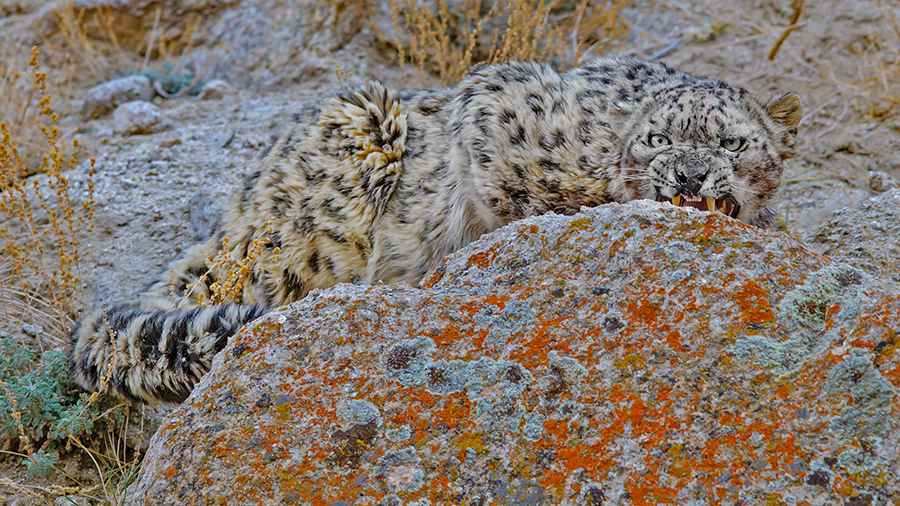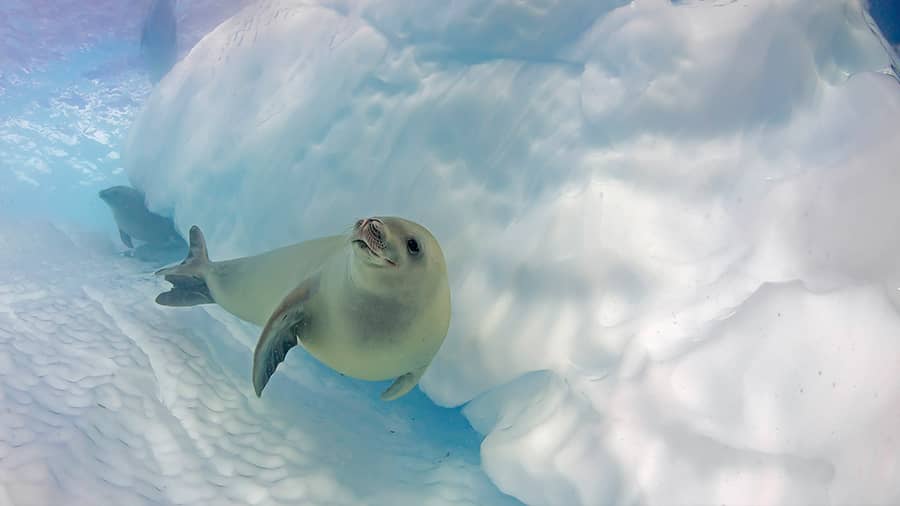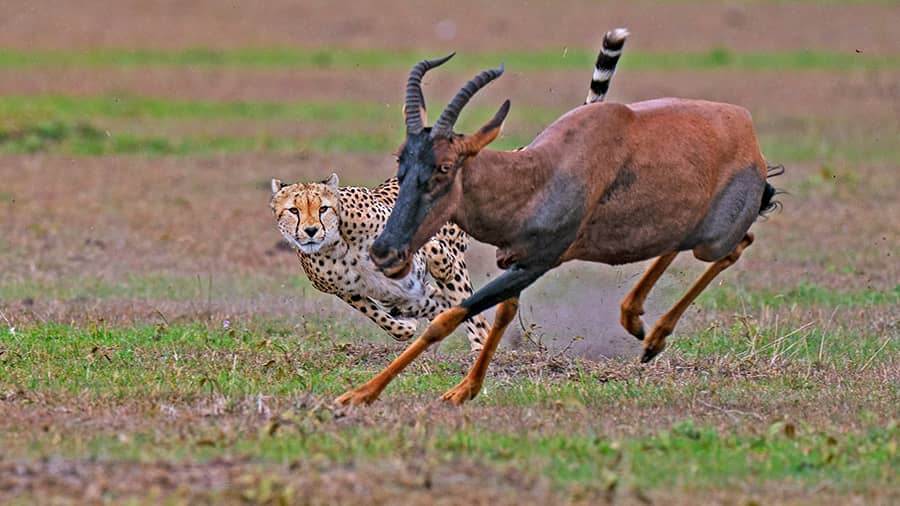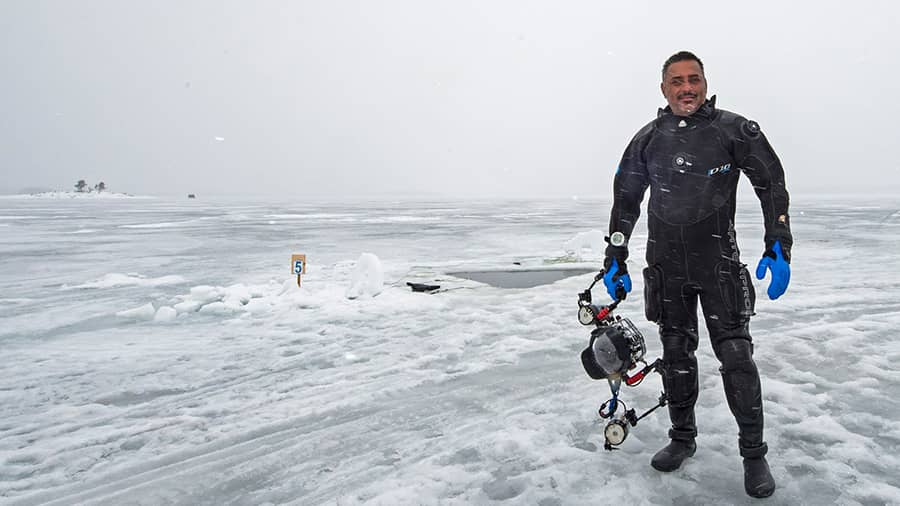“Nobody is self-taught,” believes Dhritiman Mukherjee, 47, sitting in his cosy office in Ballygunge Place. “We all learn from people around us, from our surroundings. In my case, I’ve learnt the most from animals, porters, scientists, researchers and field personnel, without whom my work wouldn’t have been possible,” says the man who has been one of India’s finest nature and wildlife photographers over the last two decades despite no formal training.
Dressed in bottle green shorts and a loose, jazzy shirt, Dhritiman is in the middle of one of his few normal days. For close to 300 days every year, he is not surrounded by a computer, a desk or fellow humans engaged in regular, mundane work. Instead, he usually keeps company with sharks, whales, snow leopards, anacondas, elephants, tigers and whichever species he wishes to study at a given point in time.
Featured by National Geographic, BBC, The New York Times, Lonely Planet, World Wide Fund (WWF) and UNESCO, among others, Dhritiman, who often calls himself a “wanderer”, was appointed by Sony India as a Sony Explorer in August 2019. A recipient of several prestigious accolades in his discipline, including the Carl Zeiss Conservation award, the RBS Earth Hero award and the Kirloskar Vasundhara Mitra award, Dhritiman is also the founder of Saveus, a nature and wildlife magazine. A couple of years ago, Dhritiman was “highly commended” in the Natural History Museums’ (NHM) Wildlife Photographer of the Year award (previously awarded by BBC), the same prize for which he is a part of the jury for 2022-23. “I don’t believe in anyone being the best in a subjective art like photography. All I’m interested in is doing things differently, in connecting people with nature and science. What excites me most about being a part of this esteemed jury is that I’ll get to see 60,000 pictures and learn from them, before a few hundred chosen by the jury are revealed to the public in London next year,” explains Dhritiman.
‘I wanted to be a full-time wildlife photographer. But I had no money’

One of the many crocodiles Dhritiman has seen from close quarters during his career
Born and brought up in Barasat to a “humble family that always retained its values”, Dhritiman is a born traveller. He was barely a year old when he made his first trip to Darjeeling. By the time he was 16 and out of school, he had started travelling without parental supervision and it was not long until he discovered his passion for rock climbing and mountaineering. After completing his graduation in physics, Dhritiman spent some time in limbo, unsure of his future path. Taking up a postgraduate diploma in ecology and environment was more of a short-term escape from academic malaise rather than a carefully constructed plan. But it was that course that opened Dhritiman’s eyes to something new. “I had already taken to photography by 1997, but studying about the environment gradually piqued my interest in nature and wildlife,” he says. By 1999, Dhritiman had found his calling: “I wanted to be a full-time wildlife photographer. But I had no money.”
For the first few years, Dhritiman’s parents supported him, going so far as selling a part of their Barasat house to equip their son with the tools needed to chase his dream. “People say that I’ve struggled. I don’t think so. It’s my parents who’ve struggled and made sacrifices so that I could live my dream,” says Dhritiman, refusing to take credit for his achievements. By 2010, Dhritiman had more than found his feet in an ever-shifting industry, and the fruits of his dedication proved to be pioneering. On an expedition to the Great Himalayan National Park in Himachal Pradesh, Dhritiman became one of the first wildlife photographers to document the Western Tragopan, a bright, medium-sized pheasant, in the wild.
Slowly but surely, Dhritiman transformed into somewhat of a wildlife superman — diving in the frozen Baikal lake in Siberia to shoot Nerpa seals one month to capturing giant American crocodiles off the Mexican coastline in the Caribbean Sea the next. From scaling mountains in Congo to obtain rare photographs of mountain gorillas to swimming through fjords in Norway to catch a glimpse of orcas (toothed whales), Dhritiman’s career has been an assortment of adventures.
‘No animal is dangerous, only situations are’

Snakes are among the coolest and calmest animals around, feels Dhritiman
Even though he has dived with anacondas in the swamps of Brazil and shot the world’s five-most lethal sharks (in terms of human casualties), Dhritiman has never felt scared. “I don’t like this narrative of animals being dangerous. No animal is dangerous, only situations are. If you provoke an animal or make them uncomfortable, that’s where danger emerges. This is why I don’t like the idea of an adrenaline rush or thrill when doing my work. If I’m getting any of those things, it means I’m going out of my way to disturb an animal or disrupt their routine, which is never my goal. Instead, my aim is to have minimal impact on an animal’s natural behaviour, to merge as perfectly as possible with their environment,” describes Dhritiman.
Tired of and disappointed by how animals are invariably framed as villainous beasts in the wild, be it in nature documentaries or movies, Dhritiman adds: “Take an anaconda, for example. When I was near one, it was the calmest, coolest animal to be around. It came and licked my lens, it had no interest in me. Most snakes don’t want to attack human beings. More so the venomous ones, because their venom is precious and they need it to hunt. And by hunt, I don’t mean hunting humans!”

The elusive snow leopard that granted Dhritiman a glimpse
Once he starts talking about animals, Dhritiman is very much in his comfort zone, talking like a proud parent about his many kids. Dhritiman not only welcomes the analogy, but endorses it, too. “This is why I don’t have a favourite animal. How can a parent choose among his kids?!” he laughs.
In spite of all his knowledge on animals, there are still moments that leave Dhritiman spellbound, suspended for a few seconds in pure joy and wonder. “I clearly remember the moment when I first saw the head of a snow leopard pop out of the snow, or when I caught my first sight of the blue whale in Sri Lanka, or when I witnessed the majesty of the coral reefs for the first time. They are what I call ‘total surprises’. You don’t know what to expect, so you just let the moment sink in,” recollects Dhritiman.
Plans with Shantanu Moitra to explore the coasts of India
In 2016, Dhritiman undertook a 100-day journey across the Himalayas with award-winning music composer Shantanu Moitra, no stranger to once-in-a-lifetime experiences himself. Produced by Roundglass, for which Dhritiman is an ambassador and creator of inventories on Indian biodiversity, the outcome was a series of videos illustrating how the awe-inspiring mountain range impacts nature, culture and people. “I really enjoyed travelling with Shantanuda. We actually have plans to do something similar, probably to explore the coasts of India this time and unveil what’s special about India’s very own geographical garland,” says Dhritiman.
As someone who is constantly on the move in some of the most daunting terrains on the planet, does Dhritiman ever feel exhausted? Or lonely? A quick and resounding “no” to both. “I’m happiest when I’m in the wilderness. During the Covid-19 lockdown, I was at home and I developed all kinds of body ache. And yet, in all my travels, I’ve never felt that. Once I was travelling to Antarctica via Argentina and had a heavy fever and chest infection as I set out from India. But the moment I dived in the cold waters in Argentina, I was fine. Nature, as always, took care of me,” smiles Dhritiman.
When he is not learning a fresh skill to equip him for the outdoors or waiting for his subject to emerge in the wild, Dhritiman loves singing, albeit rarely in public. “I’m a performer, so the things I enjoy, mostly sports and music, I love to do myself, rather than watching someone else do it.” Even so, Dhritiman remains a man of eclectic tastes, who can groove to Himesh Reshammiya as easily as he can admire Pink Floyd.
‘This is the only state where you have the Himalayas and the sea; we don’t appreciate Bengal enough’

A crab-eating seal, as captured by Dhritiman
With the pandemic receding, what is next on Dhritiman’s calendar? “I really want to explore the Northeast, especially its caves. Meghalaya was recently found to have the world’s largest cave fish. There are takins (species of goat) in Arunachal Pradesh, which I want to see. So, all that’s definitely there on my mind, as is exploring Bengal more deeply. This is the only state in India where you have the Himalayas and the sea. Given the diversity, which is a legacy of our unique topography and ecosystem, we don’t appreciate Bengal enough,” says Dhritiman.
As someone who has blazed his own trail for most of his life, Dhritiman has a simple piece of advice for those who want to take up wildlife photography: “Your success in this field isn’t about the result, it’s about the process.” He proceeds to supply context: “I spent some 14 years trying to capture a brown bear. If I had gotten the shot at the first attempt, I’d never have returned or learnt every single detail about the species. If you want to portray wildlife, you’ve got to focus on communicating something fresh. That’s also where art comes in. For me, art is the means and not the end. For many others, it’s different. Either way, you’ve got to have your vision of what you want to do and how you wish to impact viewers.”
‘There’s enough space in nature for us to coexist with other species’

Dhritiman is a firm advocate for greater respect towards other species
Just before the conversation wraps up, Dhritiman picks the final tangent he wishes to elaborate on, the topic that is perhaps the closest to his heart: conservation. “Last year, there were severe floods in Chennai, and yet, people were running out of drinking water. Why?” A couple of seconds hang in the air before Dhritiman answers his own question: “It’s because they’ve got rid of the marshlands, so the rainwater no longer reaches the ground and is instead getting mixed with the sea water.”
Dhritiman’s biggest concern pertaining to conservation is the almost wilful ignorance of the aam aadmi. “A lot of people have good intentions with respect to their environment. People want to concretise ponds, remove bushes and make everything neat and clean and good-looking. But they don’t realise that in doing so, they’re actually hampering nature in the long run. If you don’t leave a pond in its natural state, where will the rainwater go? If you get rid of the bushes near your house, where will the birds on the adjacent trees get their larvae from? We don’t think about these things, but we should,” exhorts Dhritiman, before concluding with a message that feels more like a plea: “There’s no point in having development if all that development produces is hell made out of concrete. There’s enough space in nature for us to coexist with other species. All we need to do is to look around and respect those we share our planet with.”







